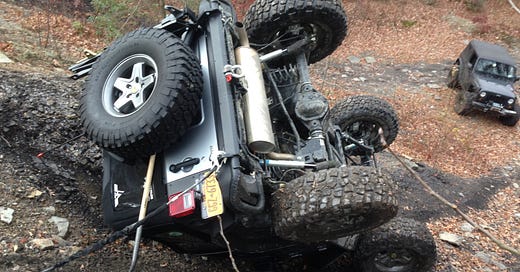No MidJourney prompt here. This actually happened. Oops. What doesn’t kill you makes you stronger, right?
“They lurrrrrve it when somesing breaks,” Philippe exhaled. “It lets them use all their leeetle toys.”
Philippe was talking about our fellow Jeep club members in his trademark heavy French accent. He was one of the only people I knew in the club that spent most of his time in Manhattan like me, rather than on the eastern end of Long Island like most of the club members. We were on a club outing, but the off-roading and rock-climbing was over for the day, so Philippe and I and some other people in the club were sitting around a campfire having dinner and talking about what went wrong with our Jeeps.
Philippe, of course, was doing his best to describe what motivates someone to take a perfectly good (and rather expensive) four wheel drive vehicle over boulders, through woods and streams, and over obstacles in search of a thrill. If you think that’s counterintuitive, he was also making the point that breaking an expensive part was sometimes a source of joy for our fellow club members.
Feeling Good About Breaking Stuff
It occurred to me that Philippe was articulating one of my favorite concepts rather well – the idea of Creative Destruction.
Your boss may have explained the concept, sharing that “sometimes you need to break some eggs to make an omelet,” or maybe they tell you to “fail faster.” The Jeep Club’s version of this was coming up with a 4WD “build” – in both concept and reality - that could conquer a day’s worth of driving over boulders and up insane inclines through the woods. After battle-testing the Jeep, whatever broke represented the weak point of the build, and it was your job as a hobbyist to think deeply about what went wrong and what tweaks to your build would give you a better day on the trails at the next club outing.
The “leeetle toys” were the specialized tools of the 4WD enthusiast – collections of spare parts, winches, toolkits, welders and air compressors – anything that could help fix a Jeep in the field or get it unstuck.
That night, Philippe was already making plans to tweak his Jeep build for the next day’s adventures. We were exactly halfway through our club trip, just as you are halfway through the journey of understanding Digital Marketing’s Deadly Sins.
Whoa… We’re Halfway There
To date, we’ve talked about digital’s problems, not spending a tremendous amount of time on solutions. That’s because we need to spend some time thinking about what Philippe and I were thinking about during that night on our Jeep Club outing – Creative Destruction.
That is, we’re taking a pause to reflect on the sins we’ve covered and how they’ve hampered the industry, with an eye toward what might be good to keep and what might be good to get rid of. It also wouldn’t hurt to think about the challenges digital marketing will have in the future, so we can tweak our build and address those coming challenges armed with something that makes sense for what we’ll be facing.
Digital Marketing’s Seven Deadly Sins are – by my reckoning – the following:
1) Arrogance
2) Failure to Respect Human Privacy
3) Obfuscation (and out-and-out Fraud)
4) Decontextualization (What I’ve been calling The Great Decoupling)
5) Overreliance on Automation
6) Playing to Metrics over Substance
You’ve stuck with me thus far, and you’re halfway there. The second half of this Substack will deal more with the solutions to the problems we’ve already discussed.
Livin’ on a Prayer
Some of those solutions will need to be tempered by what we expect to encounter on the trails the next day. There’s the transformative effects of AI and how it could exacerbate our already-excessive reliance on machines to do work that humans should be interpreting. (Incidentally, I’m working on another Substack on the transformative effects of AI called The Six-Fingered Man.)
There’s also the issue that the overall share of web advertising that is spent on the open web is continuing to shrink, as compared to the share spent within walled gardens.
All of this, of course, rolls up to an important summation – one that has implications for not just a healthy World Wide Web, but also for a healthy democracy in America. That’s this:
We destroyed the ad model.
Sorry. We had the best of intentions. But our ad model isn’t doing the thing we built it to do – underwrite creativity while it informs people about products and services.
Creativity covers a lot, from the hardest of hard news stories to the creation of new music, new stories and new art.
The Ad Model Isn’t Doing What It’s Supposed to Do
The underwriting part is happening less and less these days. Instead, we’re rewarding fraudsters and big companies that would hoard advertising wealth instead of using it to support human creativity.
And so, now it is time to think about whether we rip the transmission out of the Jeep, so we can better conquer the trails of tomorrow. What do we overhaul and what worked on yesterday’s trail ride, and shouldn’t be messed with?
While we pause around this halfway point, I want you to think deeply about Creative Destruction. Because hard choices are ahead.




